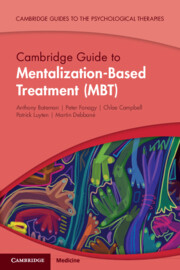Book contents
- Cambridge Guide to Mentalization-Based Treatment (MBT)
- Cambridge Guides to the Psychological Therapies
- Reviews
- Cambridge Guide to Mentalization-Based Treatment (MBT)
- Copyright page
- Contents
- Preface
- A Note from the Series Editor
- Acknowledgments
- Part I Overview of the Model
- Part II The Mentalization-Based Treatment Model in Practice
- Part III Application and Adaptations for Mental Health Presentations
- Part IV Application of Mentalization-Based Treatment in Different Populations and in Different Settings
- Chapter 13 Working with Children
- Chapter 14 Working with Adolescents
- Chapter 15 Working with Families
- Chapter 16 Working with Couples
- Chapter 17 Mentalizing in Other Settings
- Chapter 18 Mentalizing and Emergency Care
- Index
- References
Chapter 13 - Working with Children
from Part IV - Application of Mentalization-Based Treatment in Different Populations and in Different Settings
Published online by Cambridge University Press: 18 May 2023
- Cambridge Guide to Mentalization-Based Treatment (MBT)
- Cambridge Guides to the Psychological Therapies
- Reviews
- Cambridge Guide to Mentalization-Based Treatment (MBT)
- Copyright page
- Contents
- Preface
- A Note from the Series Editor
- Acknowledgments
- Part I Overview of the Model
- Part II The Mentalization-Based Treatment Model in Practice
- Part III Application and Adaptations for Mental Health Presentations
- Part IV Application of Mentalization-Based Treatment in Different Populations and in Different Settings
- Chapter 13 Working with Children
- Chapter 14 Working with Adolescents
- Chapter 15 Working with Families
- Chapter 16 Working with Couples
- Chapter 17 Mentalizing in Other Settings
- Chapter 18 Mentalizing and Emergency Care
- Index
- References
Summary
MBT-Children (MBT-C) targets the mentalizing of children and their families. A range of techniques that are tailored to the child’s mentalizing capacity are discussed in this chapter. MBT-C involves working not only with the child but also with the parents, to support their capacity to adopt a mentalizing stance toward their child. The mentalizing approach seeks to help parents to view their child as a separate person with their own mind and experiences, and to enable the parents to become more open to thinking about the mental states that might drive their child’s behavior. MBT-C is a play-centered approach. The chapter includes clinical examples that demonstrate how the intervention needs to be tailored to the child’s age and mentalizing abilities.
- Type
- Chapter
- Information
- Cambridge Guide to Mentalization-Based Treatment (MBT) , pp. 319 - 327Publisher: Cambridge University PressPrint publication year: 2023

